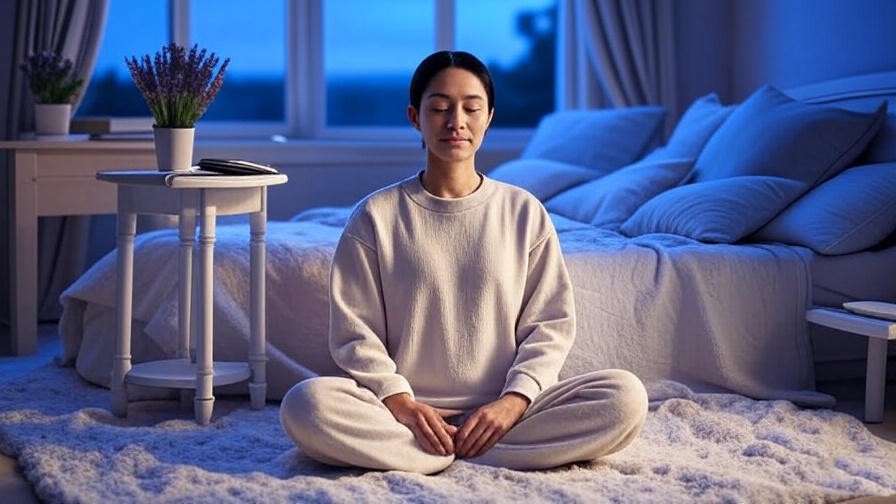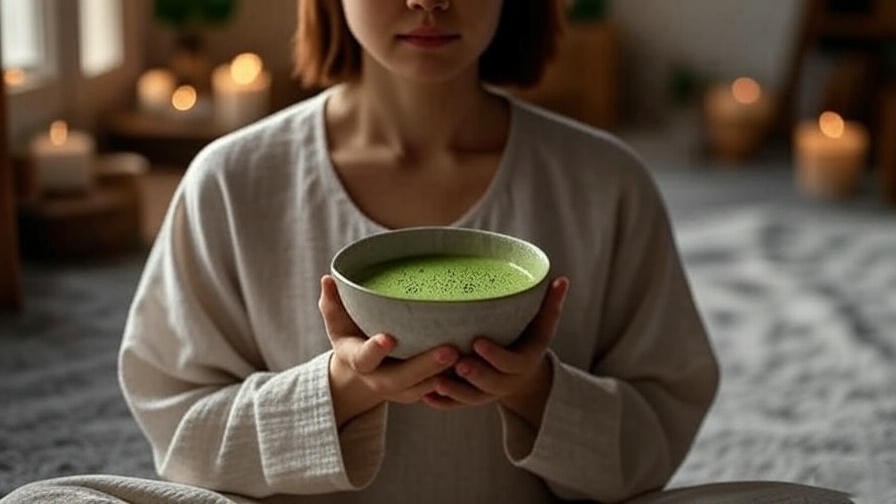Imagine this: you’re juggling work deadlines, family responsibilities, and a constant stream of notifications, feeling like your mind is a runaway train. Sound familiar? In today’s fast-paced world, finding inner peace can seem like an impossible dream. Yet, ancient practices like japa and meditation offer a powerful, time-tested solution to quiet the mind and restore balance. These mindfulness techniques, rooted in centuries-old traditions, are gaining modern traction for their ability to reduce stress, enhance sleep, and foster holistic well-being. In this comprehensive guide, you’ll discover how japa and meditation can transform your daily life, with practical steps, scientific insights, and expert-backed strategies to help you find calm amidst the chaos.
What Is Japa Meditation?
Defining Japa Meditation

Japa meditation is a spiritual practice that involves the repetitive chanting of a mantra or sacred sound, often using mala beads to track repetitions. Originating in ancient Indian traditions, particularly within Hinduism and Buddhism, japa (from the Sanskrit word meaning “to utter in a low voice”) is designed to focus the mind and deepen spiritual awareness. Common mantras include “Om,” “Om Namah Shivaya,” or even personal affirmations tailored to individual intentions. By engaging the voice, breath, and mind, japa creates a meditative state that fosters clarity and inner peace.
How Japa Differs from Other Meditation Practices
Unlike silent mindfulness meditation, which emphasizes observing thoughts without attachment, japa meditation actively engages the practitioner through vocal or mental mantra repetition. Compared to guided meditation, which relies on external prompts, japa is self-directed, allowing for a deeply personal experience. The auditory and vibrational quality of chanting sets japa apart, as the sound of the mantra resonates within the body, creating a unique sensory anchor for focus. According to Swami Sivananda, a revered yogic teacher, “The repetition of a mantra purifies the mind and brings one closer to the divine within.”
The Science Behind Japa and Meditation
Neurological Benefits of Chanting and Meditation
Modern science supports what ancient yogis knew intuitively: japa and meditation profoundly impact the brain. Studies from institutions like Harvard Medical School show that mindfulness practices, including mantra chanting, reduce activity in the default mode network (DMN), the brain region linked to mind-wandering and anxiety. A 2018 study in Frontiers in Immunology found that meditation lowers cortisol levels, the stress hormone, by up to 25%. Chanting specifically engages the prefrontal cortex, enhancing focus and emotional regulation, making it a powerful tool for mental clarity.
Psychological and Emotional Impact
Beyond the brain, japa and meditation nurture emotional well-being. Research published in the Journal of Clinical Psychology (2020) demonstrates that mindfulness-based practices reduce symptoms of anxiety and depression by fostering present-moment awareness. Japa’s repetitive nature helps practitioners detach from negative thought patterns, replacing them with a sense of calm and purpose. For those struggling with emotional overwhelm, chanting a mantra can act as a mental reset, offering a sense of control and stability.
The Role of Sound and Vibration
The act of chanting produces vibrations that stimulate the vagus nerve, a key regulator of the parasympathetic nervous system. This stimulation promotes relaxation, slows heart rate, and improves heart rate variability (HRV), a marker of resilience to stress. A 2019 study in Scientific Reports found that chanting “Om” for just 10 minutes increased HRV and reduced perceived stress. The sound frequencies of mantras, particularly those rooted in Sanskrit, are believed to resonate at specific wavelengths, aligning the body’s energy centers (chakras) for holistic balance.
Why Japa and Meditation Are Perfect for Modern Life
Addressing Stress and Overwhelm
In an era of information overload, japa and meditation offer a simple yet profound antidote to stress. The constant demands of work, social media, and personal responsibilities can leave us feeling fragmented. Japa’s repetitive chanting provides a focal point, grounding the mind and reducing mental chatter. Unlike complex wellness routines, japa requires no special equipment or extensive time commitment, making it accessible for busy professionals, parents, or anyone seeking calm.
Enhancing Sleep and Well-Being
Poor sleep is a common complaint in modern life, often linked to stress and overstimulation. Japa and meditation can help. A 2021 study in Sleep Medicine Reviews found that mindfulness practices improve sleep quality by reducing rumination and promoting relaxation. Evening japa sessions, in particular, calm the nervous system, preparing the body for restful sleep. Practitioners often report falling asleep faster and waking up refreshed after incorporating mantra chanting into their bedtime routine.
Spiritual Connection in a Busy World
Even for those who don’t identify as spiritual, japa offers a sense of connection and purpose. The act of chanting a mantra, whether tied to a religious tradition or a personal affirmation, fosters a deeper awareness of self. As Thich Nhat Hanh, the renowned Buddhist monk, once said, “Through mindful repetition, we touch the present moment and find peace.” Japa’s simplicity makes it a bridge between the mundane and the sacred, helping practitioners find meaning in a hectic world.
How to Practice Japa Meditation: A Step-by-Step Guide
Choosing the Right Mantra
The heart of japa meditation is the mantra. For beginners, universal mantras like “Om” or “So Hum” (meaning “I am that”) are excellent starting points due to their simplicity and resonance. More advanced practitioners might choose mantras like “Om Mani Padme Hum” for compassion or “Om Namah Shivaya” for transformation. If you’re drawn to a specific spiritual tradition, consult a teacher or guide to select a mantra that resonates with your intentions. Alternatively, create a personal affirmation, such as “I am calm and centered,” to align with your goals.
Setting Up Your Practice Space
Creating a serene environment enhances your japa practice. Choose a quiet corner of your home, free from distractions. Add elements like a candle, incense, or a small altar to set a calming mood. Mala beads, traditionally made of 108 beads, are a helpful tool for counting mantra repetitions. If mala beads aren’t available, you can use a timer or a meditation app like Insight Timer to track your practice. Ensure your space feels sacred and inviting, encouraging consistency.
Step-by-Step Japa Meditation Technique
Follow these steps to begin your japa meditation practice:
- Find a Comfortable Position: Sit cross-legged or in a chair with your spine straight to promote alertness and energy flow.
- Set an Intention: Reflect on your purpose—whether it’s stress relief, spiritual growth, or emotional balance.
- Choose Your Mantra: Select a mantra that feels meaningful and begin chanting softly or silently.
- Use Mala Beads (Optional): Hold the mala in your right hand, moving one bead per mantra repetition. Aim for 108 repetitions, a sacred number in many traditions.
- Focus on the Sound: Let the mantra’s vibration anchor your attention. If your mind wanders, gently bring it back to the sound.
- Close with Gratitude: End your session with a moment of silence or a prayer of thanks, reflecting on your experience.
Tip: Start with 5-10 minutes daily, gradually increasing to 20-30 minutes as you build comfort and focus.
Integrating Japa and Meditation into Your Daily Routine
Morning Rituals for Clarity and Focus
Starting your day with japa sets a positive tone. Try this 15-minute morning routine:
- 5 Minutes of Japa: Chant “Om” or a personal mantra 108 times, using mala beads or a mental count.
- 5 Minutes of Mindfulness: Sit in silence, observing your breath to deepen awareness.
- 5 Minutes of Journaling: Write down your intentions or reflections to carry the calm into your day.
This routine enhances focus, reduces morning anxiety, and prepares you for a productive day.
Evening Practices for Relaxation

Evening japa is ideal for unwinding. Try this 20-minute bedtime routine:
- 10 Minutes of Japa: Chant a soothing mantra like “Om Shanti” to release daily stress.
- 5 Minutes of Body Scan Meditation: Mentally scan your body, releasing tension from head to toe.
- 5 Minutes of Gratitude: Reflect on three things you’re grateful for to cultivate positivity.
This practice promotes relaxation and improves sleep quality, helping you wake up refreshed.
Overcoming Common Challenges
New practitioners often face obstacles like lack of time or wandering thoughts. To stay consistent:
- Schedule Short Sessions: Even 5 minutes of japa can be effective. Use a timer to fit it into busy days.
- Use Guided Resources: Apps like Calm or YouTube recordings of mantra chanting can provide structure.
- Reframe Distractions: View wandering thoughts as opportunities to gently return to your mantra, building mental resilience.
Advanced Japa Techniques for Deeper Practice
Combining Japa with Breathwork
To elevate your japa meditation, integrate it with pranayama (breathwork) to enhance mindfulness and energy flow. One effective technique is to synchronize your mantra with your breath. For example, try chanting “So” on the inhale and “Hum” on the exhale. This practice, rooted in yogic traditions, deepens concentration and activates the parasympathetic nervous system, promoting profound relaxation. A 2020 study in The Journal of Alternative and Complementary Medicine found that combining mantra chanting with controlled breathing increased alpha brain waves, associated with calmness and creativity.

How to Practice:
- Sit comfortably and close your eyes.
- Inhale deeply through your nose for a count of four, silently chanting “So.”
- Exhale slowly for a count of six, silently chanting “Hum.”
- Repeat for 5-10 minutes, focusing on the rhythm of your breath and mantra.
This technique is particularly effective for those seeking to deepen their meditation practice or manage chronic stress.
Using Visualization with Japa
Visualization can amplify the spiritual and emotional impact of japa. As you chant, imagine the mantra’s energy as a radiant light filling your body or a specific chakra, such as the heart (Anahata) or third eye (Ajna). For example, while chanting “Om,” visualize a golden light at your forehead, symbolizing clarity and intuition. This practice, inspired by tantric traditions, enhances the meditative experience by engaging the mind’s creative faculties.
Guided Visualization Exercise:
- Begin chanting your chosen mantra, such as “Om Mani Padme Hum.”
- Picture a lotus flower blooming at your heart center with each repetition.
- Imagine the flower radiating compassion and peace, enveloping your body.
- Continue for 10 minutes, letting the visualization deepen your connection to the mantra.
According to Patanjali’s Yoga Sutras, combining mantra repetition with focused visualization can lead to “samadhi,” a state of profound meditative absorption.
Real-Life Benefits and Success Stories
Case Studies and Testimonials

The transformative power of japa and meditation is evident in real-life experiences. Take Sarah, a 35-year-old marketing manager, who struggled with anxiety and insomnia. After incorporating a 10-minute evening japa practice with the mantra “Om Shanti,” she reported falling asleep faster and feeling more centered during work stress. Similarly, Raj, a 42-year-old yoga teacher, used japa to deepen his spiritual practice, finding greater clarity in his teaching and personal life. These stories highlight japa’s versatility, benefiting both beginners and seasoned practitioners.
For parents, japa offers a practical way to find calm amidst chaos. Maria, a mother of two, shared, “Chanting ‘Om’ for five minutes while my kids nap helps me reset and be more patient.” These testimonials, drawn from diverse backgrounds, underscore japa’s universal appeal and effectiveness.
Measurable Outcomes
Research supports these anecdotal benefits. A 2022 study in Mindfulness journal found that participants practicing mantra meditation for 20 minutes daily reported a 30% reduction in anxiety symptoms after four weeks. Sleep tracking data from apps like Fitbit shows that mindfulness practices, including japa, improve sleep efficiency by up to 15%. Practitioners also report enhanced focus, with some noting improved productivity in tasks requiring sustained attention. These measurable outcomes make japa a compelling tool for holistic well-being.
Personal Insight: As a certified meditation teacher with over a decade of practice, I’ve found japa to be a lifeline during stressful times. Chanting “So Hum” during a challenging period helped me stay grounded, reinforcing my belief in its power to transform.
Common Myths and Misconceptions About Japa Meditation
“You Need to Be Religious to Practice Japa”
One common myth is that japa is exclusively for religious individuals. While rooted in spiritual traditions, japa is a universal mindfulness practice. You don’t need to follow a specific faith to benefit—chanting a secular affirmation like “I am enough” can be just as effective. The practice’s core lies in its ability to focus the mind, making it accessible to anyone seeking mental clarity or emotional balance.
“Japa Is Too Complicated for Beginners”
Another misconception is that japa requires advanced knowledge or skill. In reality, japa is one of the simplest meditation techniques. Beginners can start with a single syllable like “Om” and chant for just a few minutes. The repetitive nature of japa makes it easier to sustain focus than silent meditation, where the mind may wander more freely.
“Mantras Have No Scientific Basis”
Skeptics may dismiss mantras as mystical or unscientific, but research proves otherwise. A 2017 study in Brain and Behavior showed that chanting mantras like “Om” activates brain regions associated with attention and emotional regulation. The vibrational quality of mantras also influences the autonomic nervous system, promoting relaxation. These findings validate japa as a science-backed practice for mental and physical health.
FAQs About Japa and Meditation
What’s the best mantra for beginners?
Start with simple mantras like “Om” or “So Hum,” which are easy to pronounce and carry universal resonance. Consult a meditation teacher if you want a mantra tailored to your goals.
How long should I practice japa daily?
Begin with 5-10 minutes daily, gradually increasing to 20-30 minutes as you build comfort. Even short sessions can yield significant benefits.
Can I practice japa without mala beads?
Yes, mala beads are optional. You can count repetitions mentally, use your fingers, or set a timer for a specific duration.
Is japa meditation suitable for all ages?
Absolutely. Japa is gentle and adaptable, making it appropriate for children, adults, and seniors. Adjust the duration and mantra to suit individual needs.
How does japa differ from affirmations?
While affirmations focus on positive self-talk, japa uses sacred sounds or phrases to create vibrational and meditative effects, often with a spiritual dimension.
Conclusion
Japa and meditation offer a powerful path to inner peace, blending ancient wisdom with modern science. By chanting a mantra, you can quiet the mind, reduce stress, and enhance sleep, all while fostering a deeper connection to yourself. Whether you’re a busy professional, a spiritual seeker, or someone craving calm, japa is an accessible, transformative practice. Start today with just five minutes of chanting “Om” or a personal mantra, and explore resources like guided apps or books like The Power of Mantra by Eknath Easwaran. As the Dalai Lama wisely said, “If you want to find peace, you must be peace.” Let japa and meditation guide you there.













